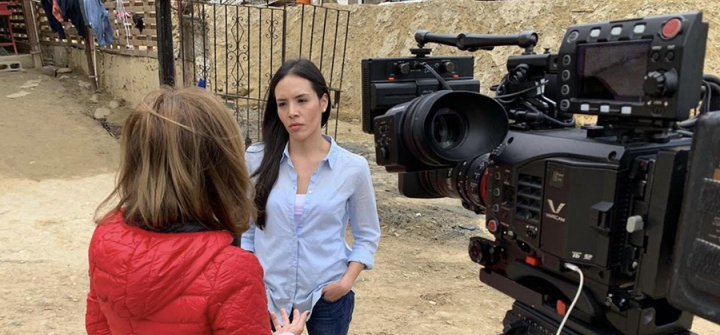Another Way to Fight Disease: Media Training
It is only a matter of time before the next deadly infectious disease wreaks havoc somewhere in the world. Do we respond like we did when we stopped smallpox?
Or do we prolong the crisis and create collateral damage such as xenophobia and lost jobs, as we have done in response to COVID-19 and recent Ebola outbreaks?
Our new publication in Academic Medicine shows a way to help the public make wise health choices using a proven strategy: empowering doctors, especially those going into global health, to become better communicators by providing training and practice in the fundamentals of ethical journalism and storytelling.
Over the years, we’ve seen the same lethal pattern repeat itself. Global health issues are largely ignored by Western media until they’ve reached full-on crisis proportions, at which point they enter the relentless 24/7 cable news and social media cycle. Then, too often, commentators with little or no scientific training sensationalize the story and provide misleading or false information. The resulting infodemic then exacerbates the medical epidemic.
And with the COVID-19 pandemic, millions of people have opted not to be vaccinated, swayed by anti-vaccine misinformation and falsehoods. Many of them lost their lives as a result: The Kaiser Family Foundation estimated that 163,000 U.S. deaths from COVID-19 between June and November 2021 could have been prevented with vaccines.
The antidote to such misinformation contagions? Accurate, transparent scientific information delivered by a trusted source. We need to fill the information void, inoculating the public with solid scientific information before crises develop. And when crises happen, we need experts who can share timely, trustworthy information.
Doctors, as some of the most trusted professionals in the US, are uniquely positioned to be such messengers. However, few leave medical school knowing how to shed the technical jargon of their training and communicate effectively with the public.
Our Academic Medicine article reviews the Stanford Global Health Media Fellowship as a model for training physician-communicators and encourages medical schools worldwide to develop similar programs.
The Stanford Center for Innovation in Global Health launched this first-of-its-kind fellowship in 2011 in collaboration with NBC News chief medical correspondent. Its goal: Train physicians to proactively share global health stories with the public and provide trustworthy, factual information in times of medical crisis.
The fellowship enables a medical school student each year to master the principles of storytelling and multimedia and medical journalism through journalism school training and an intensive internship with Sanjay Gupta at CNN, as well as a capstone global health project. To date, the program has produced 10 skilled global health communicators with medical training. These alumni, most of them doctors, now convey medical insights and expertise through compelling television interviews, engaging blogs, and powerful op-eds.
A former fellow, Michael Nedelman, now works at CNN Health as a producer and described the value of the fellowship this way: “In medical school, you develop some habits that are great for doctors, but bad for journalism.” For example, doctors are trained to deliberate in delivering a diagnosis, first presenting the facts, and eventually getting to assessment, diagnosis, and treatment. While this works for medicine, it is often inappropriate for journalism, where it’s critical to lead with the most important parts to draw the reader in.
The fellowship has enabled alumni like Nedelman and others to effectively share their medical know-how for the benefit of a public audience. For instance, Edith Bracho-Sanchez launched “Las Doctoras Recomiendan,” a podcast distributed by Univision intended to provide Latino families advice on topics including pediatrics, COVID-19, nutrition, and sleep. She uses this podcast and accompanying Q&A platform on social media to inform a demographic that the American health care system has often neglected.
We are encouraged that many communications training programs for medical students and doctors have developed since 2011 to help create this kind of impact. Still, the world needs more diverse expert medical communicators, especially as newsrooms shrink and the number of trained science journalists declines.
More fellowships like Stanford’s are needed, and we encourage medical schools and global health centers to adopt such models where possible.
Medical schools and journalism schools could partner to incorporate basic media training into regular medical education, as author and former fellow Kristina Krohn, is doing at the University of Minnesota.
Alternatively, medical schools across the US could offer elective rotations for medical students or residents by pairing medical trainees with journalism students and local news stations to improve the quality of local medical news and learn key aspects of quality, timely medical reporting. Experience as a researcher for medical news stories could provide medical students valuable lessons on the inner workings of newsrooms.
Doctors build trust when they break down the silos of their academic research or medical practice to speak directly with the public. And trust saves lives, as evidenced by a recent Lancet study, which found high levels of trust in government were associated with lower COVID-19 infection rates.
Let’s offer our physicians-to-be one more lifesaving tool by training them in the art of good, transparent communication.
Edith Bracho-Sanchez interviews a source in Tijuana, Mexico in 2019. Image: Courtesy





